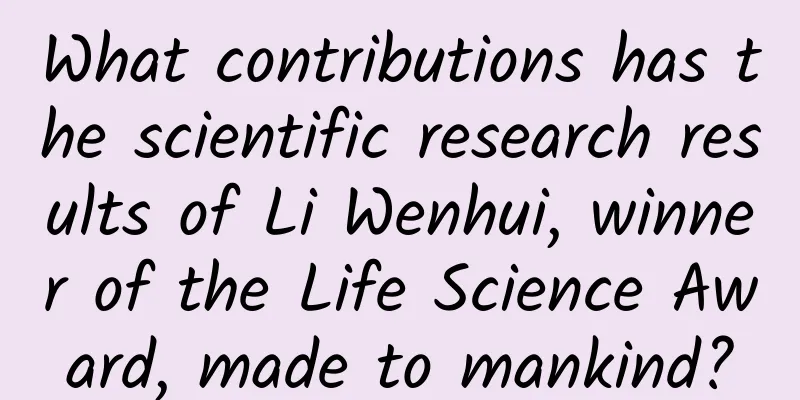What contributions has the scientific research results of Li Wenhui, winner of the Life Science Award, made to mankind?

|
On the morning of August 21, the 2022 Future Science Prize was announced. A total of three big names won three awards. They are: Li Wenhui, winner of the "Life Science Award", Yang Xueming, winner of the "Material Science Award", and Mo Yiming, winner of the "Mathematics and Computer Science Award". Today I want to talk to you about Li Wenhui, the winner of the "Life Science Award". What contributions has he made? Let’s start with the most basic science – receptors, and talk about Li Wenhui’s contribution – the discovery that the receptor for hepatitis B and D viruses to infect humans is the sodium-taurocholic acid cotransporter (NTCP). 01. Basic science: What are receptors? Receptor, as the name suggests, is the body that receives cough cough. In fact, the concept of receptor is very broad. A receptor refers to any biological macromolecule that can bind to hormones, neurotransmitters, drugs or intracellular signaling molecules and cause changes in cell function. It’s too professional, so let’s talk about it from a smaller perspective: viral receptors. In fact, viruses do not drill into cells as we imagine. This underestimates the defense ability of cells. In fact, since the birth of cells, they have started to screen foreign substances. They do not reject all comers, but only those who have a secret key can enter. It is like a door lock that can only be opened by those who have the key. And this lock can be commonly understood as a receptor. For example, in the picture below, the orange circle in the upper left corner can be understood as foreign matter, and the purple one is the receptor. If the two match, let it in; if they don’t match, reject it. In fact, since the outbreak of the COVID-19, many people probably have some understanding of receptors, such as the COVID-19 receptor ACE2. As mentioned above, the spike of the new coronavirus is like a key, and the receptor is the lock. When the two match, the new coronavirus comes in, and this is infection. 02. Hepatitis B receptor As a virus, hepatitis B also needs receptors. In fact, the research on hepatitis B receptors has been going on for many years, but what has been found are some specious receptors, which makes many people quite annoyed. Li Wenhui’s important contribution was the discovery of this receptor, which was published in the article he published in eLife that year. In the article, the scientific research team led by Li Wenhui used a series of methods to repeatedly verify and determined that the sodium ion-taurocholic acid cotransporter (NTCP) is the receptor required for hepatitis B. Specifically, HBV entry into cells is mediated by the HBV envelope protein, and the pre-S1 domain of the envelope protein is the key determinant of receptor binding. So he went looking for a protein that binds to pre-S1 and finally found NTCP. In turn, NTCP will also affect the infection process of hepatitis B. Anyway, this thing is quite professional. If you are interested, you can read this article, it is free. Let's use a simple picture to represent it: 03. What is the use of this discovery? The main significance is the research and development of new drugs for the treatment of hepatitis B. Hepatitis B is a global infectious disease, and it is estimated that many people have encountered this problem during physical examinations. my country is a major country for hepatitis B. It is estimated that there may be more than 90 million hepatitis B carriers and more than 30 million patients. This has also led to a very large scale of hepatitis B, which is very difficult to control. Moreover, hepatitis B itself can be transmitted through blood, mother-to-child and sexual contact. Fortunately, there is a hepatitis B vaccine, which can reduce the number of hepatitis B cases to some extent. However, it is still a big challenge to treat hepatitis B. Therefore, finding the hepatitis B receptor undoubtedly adds an option for drug development. The above picture shows the entire pathway of hepatitis B infection, many of which can be used to design drugs. Of course, in addition to hepatitis B, this receptor is also related to hepatitis D. 04. About NTCP In fact, there have been many studies on NTCP in recent years. Li Wenhui conducted in vitro research, while Professor Wang Yiming and Professor Gao Zhiliang of Sun Yat-sen University conducted research on patients with chronic hepatitis B, further confirming that NTCP is the hepatocyte receptor for hepatitis B virus. There was also an article in Nature this year that analyzed the structure of the NTCP receptor. |
<<: Relay satellites: making manned space flight and deep space exploration more convenient
Recommend
"91 Ten Articles" - A must-read daily briefing for the new energy vehicle industry (210226)
1. Huawei plans to cooperate with Changan Automob...
IDC: Market share of major vendors in China's hospital resource planning system (HRP) market in 2021
IDC recently released "China's Hospital ...
Don’t know how to do community operations? Try these 5 ideas for user operations
Community operation has been very popular recentl...
How to do short video marketing? What are the short video marketing techniques?
Now that short videos have become the traffic ent...
How can APP use growth hacking methods to achieve 400,000 growth?
This article uses the growth hacker methodology a...
How long does it take to review Tencent’s advertising account opening? How to check the account opening results?
Review time limit How long does the account openi...
How much does mutton cost per pound? What is the current market price of mutton?
With the arrival of autumn, the demand for mutton...
Listen to Chen Dong’s growth story: It feels so good to have a dream come true!
At 10:44 a.m. Beijing time on June 5, 2022, the L...
Strategies and methods for operating hot products on Xiaohongshu
We love and hate Xiaohongshu . What we love is th...
Google's Fuchsia OS has been launched on the first generation Nest Hub
In May of this year, Google officially confirmed ...
Air quality actually affects box office? !
Copywriter: Tianlan Editorial Office Layout: Rour...
"The fourth shot" vaccine, can I still get it if I have a positive test result? What should I pay attention to when getting vaccinated? Expert interpretation →
On December 14, the National Health Commission re...
Want to eat "Martian rice", how to transform the farm?
Recently, the color version of China's first ...
WiseApp: In 2024, Korean users will use generative AI applications 900 million times per month, with ChatGPT leading the way
According to the latest data, South Korea's g...
If Weibo Blue V certification fails, do I need to pay 300 yuan again to apply for certification again?
No, you only need to provide the failed materials...









